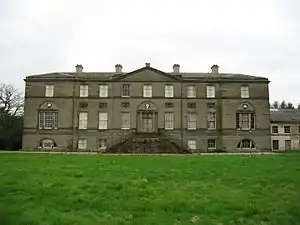Samuel Wyatt
Samuel Wyatt (8 September 1737, Weeford, Staffs. – London, 8 February 1807) was an English architect and engineer. A member of the Wyatt family, which included several notable 18th- and 19th-century English architects, his work was primarily in a neoclassical style.
Career

In his twenties, Wyatt was master carpenter and later Robert Adam's clerk of works at Kedleston Hall in Derbyshire, which was a landmark in English neoclassical architecture. He later worked with his brother James Wyatt on the Pantheon in Oxford Street, London. He designed neoclassical country houses such as Tatton Park in Cheshire, and Trinity House in London and Digswell House in Hertfordshire.
Wyatt's career was diverse. He designed the Albion Mills in London, which was the first in the world to be powered by steam engines, and patented designs for cast iron bridges. He designed model farm buildings, cottages, and several lighthouses, including those at Dungeness, Longships and Flamborough Head.
Between 1784 and 1807 Samuel worked as architect to the Holkham Hall estate,[1] he designed several farms, 'The Great Barn' as well as the new kitchen garden with its hothouses, including 'The Vinery'. He used a simplified new-classical style for these buildings.
In 1791 Samuel was hired by Rev Edward Hughes to design and build an early version of Kinmel Hall in Abergele, Wales, which he completed in 1802 and which is referred to as the Wyatt Kinmel.
Samuel Wyatt developed a friendship with Matthew Boulton, for whom he designed Soho House in the Handsworth Staffordshire (now Birmingham) in 1789. Prior to this, Boulton recommended him to the proprietors of the Theatre Royal on New Street, Birmingham in 1777, and in 1780, a portico of coupled Ionic columns between arched wings was added to the front of the theatre to a design by Wyatt. It is also believed that he was recommended by Boulton to James Watt, for whom Wyatt designed Heathfield House in Handsworth. This was completed in 1790. He was also responsible for work at Moseley Hall in the Moseley area of Birmingham.
Together with Charles Tatham he also designed Dropmore House in Buckinghamshire, which was built in the 1790s for the prime minister at the time, Lord Grenville, who pushed through the law abolishing the slave trade.[2] At the turn of the 19th century, he remodelled and extended Shugborough Hall for Viscount Anson.
Gallery of architectural work
 Tatton Hall, Cheshire
Tatton Hall, Cheshire Trinity House, London (Samuel's work is in stone on the left)
Trinity House, London (Samuel's work is in stone on the left).jpg.webp) Soho House, Staffordshire
Soho House, Staffordshire Heathfield Hall - 1835 painting by Allen Edward Everitt
Heathfield Hall - 1835 painting by Allen Edward Everitt Shugborough Hall, Staffordshire
Shugborough Hall, Staffordshire Doddington Hall, Cheshire
Doddington Hall, Cheshire The Great Barn, Holkham estate Norfolk
The Great Barn, Holkham estate Norfolk Belmont House, Throwley, Kent, built 1789–1793 for Colonel John Montresor
Belmont House, Throwley, Kent, built 1789–1793 for Colonel John Montresor Kinmel Hall, Abergele
Kinmel Hall, Abergele.jpg.webp) Flamborough Head Lighthouse, Yorkshire
Flamborough Head Lighthouse, Yorkshire
See also
References
- Martins, Susanna Wade. "A Great Estate At Work: The Holkham Estate and its Inhabitants in the Nineteenth Century". Cambridge University Press, 1980. 155. ISBN 0-521-22696-1
- Timpson, Trevor (1 April 2007). "Abolitionist's house escapes ruin - BBC news 1 April 2007". BBC News. Retrieved 6 February 2009.
- Douglas Hickman (1970). Birmingham. Studio Vista Ltd. p. 5.
External links
- John Martin Robinson's doctoral thesis, "Samuel Wyatt, architect" via Oxford Research Archive